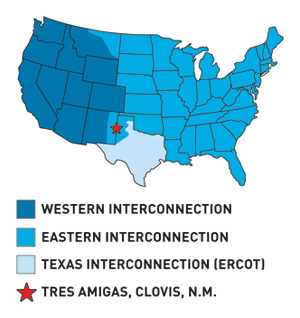
A huge plot of rural land in eastern New Mexico could soon become a major power hub for the U.S. if a start-up merchant transmission company is successful. Tres Amigas LLC, based in Santa Fe, N.M., is developing a nearly $2-billion project to interconnect the three main power grids in the U.S.
Last month, Tres Amigas filed papers with the city of Clovis, N.M., to issue $1.65-billion in industrial revenue bonds for the construction of the facility on 14,400 acres of land approximately 12 miles north of the city. Due to complex negotiations with various stakeholders, the start date has been gradually pushed back from 2011 to January 2013.
Because the three main U.S. power grids (see map) are asynchronous, there are very few connections that can convert and transmit power. Tres Amigas' plan would connect them, and exploit price differences between the three grids. Power could be transferred from the cheapest production point to where it is most valuable. "We are going to be able to allow energy producers and consumers to have another way of securing their energy supply," says David Stidham, chief operating officer of Tres Amigas.
The project is also expected to expand investment opportunities in renewable energy. "What happens when you have a whole bunch of solar energy in the Western grid, and you'd like to be able to sell or use that power in the Eastern grid?" asks Steve Eckroad, technical executive with Palo Alto, Calif.-based non-profit Electric Power Research Institute. "There isn't the capacity to transport that power because the grids are asynchronous."
The project would be built in three initial phases, with three more to follow as demand grows. Phase one would provide 750 MW of interconnectivity between the east and west grids, at an estimated cost of $500 million. The $400-million second phase would add 1.5-GW interconnectivity between the Electric Reliability Council of Texas and the east and another 750 MW between ERCOT and the west. Estimated at $1 billion, phase three will increase the power exchange amount up to 5 GW.
Clovis was chosen for its 40-mile proximity to all three grids. Industrial revenue bonds will exempt Tres Amigas from millions of dollars in property tax, in exchange for creating an expected 150 permanent jobs, says Gene Hendrick, economic development specialist with the Clovis Industrial Development Corp.
The project hinges upon negotiating interconnection agreements with each of the three grids. The Western Interconnection agreement is in place, and the Eastern Interconnection is being finalized, Stidham says.
The agreement with the ERCOT is more complicated, since it currently isn't regulated by the Federal Energy Regulatory Commission as the other two grids are. ERCOT prefers to keep its independence and participation requires a waiver allowing it to remain outside of FERC's jurisdiction. Stidham says the agency indicates "that our interconnections will not place ERCOT under their jurisdiction. FERC recently set a precedent with San Francisco-based Pattern Energy's Southern Cross project, which will connect ERCOT with the eastern grid upon completion in 2016.
Tres Amigas has raised enough funding to begin design and development, with more investment kicking in once the second interconnect agreement is in place. Japanese industrial infrastructure services firm Mitsui & Co. Ltd. has invested $12 million in the project, to promote its smart grid and renewable energy management technology internationally. Tres Amigas has also hired several engineering firms, including Hailey, Idaho-based POWER Engineers to perform design engineering, Burns & McDonnell, Kansas City, Mo., to provide power-flow studies and Denver-based CH2M HILL as program manager.
Since Tres Amigas will be the first U.S. project of this type, finding a contractor that is willing to assume the liability of the project's successful operation has been more of a challenge, Stidham says. "They are used to building high-voltage switching stations and high-voltage transmission lines, but when you incorporate those with a voltage source converter, it's hard to get your hands around the technology and to guarantee that it's going to work once its built," he adds.
Construction would involve extensive transmission lines, a warehouse and administration buildings and large buildings to house the voltage source converters, which will be manufactured in the U.K. by the Alstom Grid under a $200-million contract. The real boon, though, won't come directly from Tres Amigas' construction jobs, but from the expected influx of transmission lines and renewable energy producers to the area, Hendrick says. "A shortage [of] transmission capacity [is] keeping us from developing our excellent wind and solar possibilities," he says. "We are hoping that as soon as activity begins at Tres Amigas, transmission companies will be out here immediately trying to get a leg up in stringing lines."
As New Mexico nears capacity on its transmission lines, it faces pressure to compete with neighboring states for renewable development. Texas is currently completing its $7-billion Competitive Renewable Energy Zones (CREZ) transmission line project, which facilitates renewable energy development by interconnecting wind farms in the Panhandle and west Texas to the large metropolitan areas to Dallas and other large metro areas. Ironically, it was CREZ that makes Tres Amigas feasible by bringing ERCOT connections within close proximity to the other two power grids near the Panhandle.
Early on, Tres Amigas announced plans to use underground superconducting DC cables to transmit power in the project. Stidham now says they are not planning to introduce the technology until the third phase. While superconductivity cables are vastly more efficient than traditional copper lines, the technology has only been used in several test cases in the U.S., making its adoption in the risk-adverse power industry very slow, Eckroad says. The adoption of superconductivity has also been hindered by the Dept. of Energy’s freezing of funding for more tests under the current administration. “I am very hopeful that Tres Amigas will be able to go ahead because we do need to have a continuing presence [in superconductivity use],” he adds.



Post a comment to this article
Report Abusive Comment